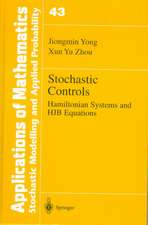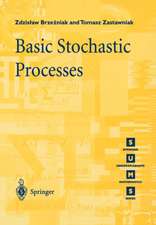Deterministic Aspects of Mathematical Demography: An Investigation of the Stable Theory of Population including an Analysis of the Population Statistics of Denmark: Biomathematics, cartea 13
Autor J. Impagliazzoen Limba Engleză Paperback – 10 ian 2012
Din seria Biomathematics
-
 Preț: 395.09 lei
Preț: 395.09 lei -
 Preț: 385.62 lei
Preț: 385.62 lei -
 Preț: 395.63 lei
Preț: 395.63 lei -
 Preț: 398.15 lei
Preț: 398.15 lei -
 Preț: 391.40 lei
Preț: 391.40 lei -
 Preț: 391.02 lei
Preț: 391.02 lei -
 Preț: 402.38 lei
Preț: 402.38 lei -
 Preț: 404.67 lei
Preț: 404.67 lei -
 Preț: 394.51 lei
Preț: 394.51 lei - 15%
 Preț: 704.04 lei
Preț: 704.04 lei - 15%
 Preț: 504.02 lei
Preț: 504.02 lei -
 Preț: 386.22 lei
Preț: 386.22 lei - 15%
 Preț: 654.43 lei
Preț: 654.43 lei -
 Preț: 390.25 lei
Preț: 390.25 lei -
 Preț: 390.63 lei
Preț: 390.63 lei -
 Preț: 405.06 lei
Preț: 405.06 lei -
 Preț: 398.74 lei
Preț: 398.74 lei - 15%
 Preț: 596.46 lei
Preț: 596.46 lei
Preț: 384.48 lei
Nou
Puncte Express: 577
Preț estimativ în valută:
73.57€ • 76.82$ • 60.75£
73.57€ • 76.82$ • 60.75£
Carte tipărită la comandă
Livrare economică 15-29 aprilie
Preluare comenzi: 021 569.72.76
Specificații
ISBN-13: 9783642823213
ISBN-10: 3642823211
Pagini: 204
Ilustrații: XII, 188 p. 1 illus.
Dimensiuni: 170 x 244 x 11 mm
Greutate: 0.33 kg
Ediția:Softcover reprint of the original 1st ed. 1985
Editura: Springer Berlin, Heidelberg
Colecția Springer
Seria Biomathematics
Locul publicării:Berlin, Heidelberg, Germany
ISBN-10: 3642823211
Pagini: 204
Ilustrații: XII, 188 p. 1 illus.
Dimensiuni: 170 x 244 x 11 mm
Greutate: 0.33 kg
Ediția:Softcover reprint of the original 1st ed. 1985
Editura: Springer Berlin, Heidelberg
Colecția Springer
Seria Biomathematics
Locul publicării:Berlin, Heidelberg, Germany
Public țintă
GraduateCuprins
1. The Development of Mathematical Demography.- 1.1 Introduction.- 1.2 Demography Before the Eighteenth Century.- 1.3 The Life Table — Definitions and Consequences.- 1.4 The Life Table — Practical Considerations as a Population Model.- 1.5 Early Models of Population Projections.- 1.6 Mortality and Survival Revisited.- 1.7 Conclusion.- 1.8 Notes for Chapter One.- 2. An Overview of the Stable Theory of Population.- 2.1 Introduction.- 2.2 Duration of Events Compared to Time.- 2.3 Population Pyramids and Age-Specific Considerations.- 2.4 Classical Formulation of the Stable Theory of Population.- 2.5 An Overview of Deterministic Models in Stable Population Theory.- 2.6 Conclusion.- 2.7 Notes for Chapter Two.- 3. The Discrete Time Recurrence Model.- 3.1 Introduction.- 3.2 Linear Recurrence Equations — A Pandect.- 3.3 The Discrete Time Recursive Stable Population Model.- 3.4 Conclusion.- 3.5 Notes for Chapter Three.- 4. The Continuous Time Model.- 4.1 Introduction.- 4.2 The Development of the Continuous Time Model.- 4.3 Solution of the Continuous Model According to Lotka.- 4.4 Considerations on the Continuous Model According to Feller.- 4.5 Asymptotic Considerations.- 4.6 Conclusion.- 4.7 Notes for Chapter Four.- 5. The Discrete Time Matrix Model.- 5.1 Introduction.- 5.2 Development of the Discrete Time Matrix Model.- 5.3 Population Stability and the Matrix Model.- 5.4 Stable Theory when the Eigenvalues are Distinct.- 5.5 Stable Theory with Eigenvalues Not all Distinct.- 5.6 Conclusion.- 5.7 Notes for Chapter Five.- 6. Comparative Aspects of Stable Population Models.- 6.1 Introduction.- 6.2 Similarities Among the Stable Models.- 6.3 Differences Among the Stable Models.- 6.4 Conclusion.- 6.5 Notes for Chapter Six.- 7. Extensions of Stable Population Theory.- 7.1Introduction.- 7.2 Some Parameters of Stable Population Theory.- 7.3 Some Fertility Measures in Stable Population Theory.- 7.4 Some Applications of Stable Population Theory.- 7.5 Perturbations of Stable Population Theory.- 7.6 Conclusion.- 7.7 Notes for Chapter Seven.- 8. The Kingdom of Denmark — A Demographic Example.- 8.1 Introduction.- 8.2 A Chronological Summary of Demographic Data Retrieval in Denmark.- 8.3 Migration, Mortality and Fertility in Denmark.- 8.4 Conclusion.- 8.5 Notes for Chapter Eight.- The Continuous Time Model According to McKendrick — von Foerster.- References.














